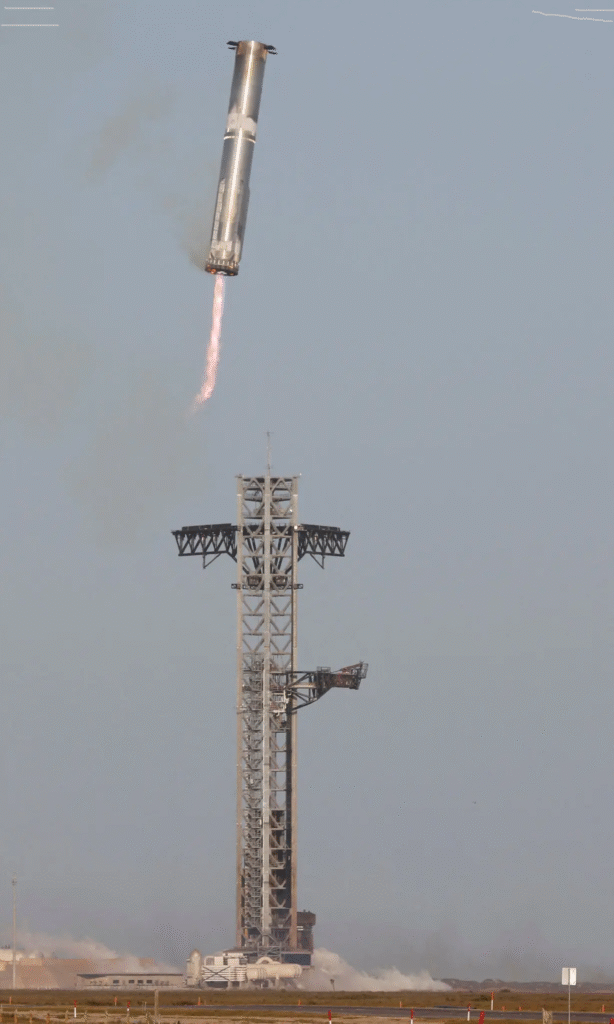SpaceX Starship’s patchy history gets worse when it loses control of it.
Following the fall of debris from January and March flights into the Atlantic Ocean, which caused air traffic disruptions, Elon Musk’s massive moon and Mars rocket had a lot at stake on Flight 9.
The largest and most powerful rocket ever created, SpaceX’s Starship, successfully reached space but failed to return to Earth.
The upper stage vehicle flew through space on Tuesday, surpassing flights in January and March that ended in explosions and showers of debris over the Atlantic Ocean. However, the spaceship experienced a propellant leak halfway through its unmanned voyage. As a result, it began to spin out of control. The Starship spacecraft utilized in the test flight disintegrated as it reentered the atmosphere due to the extreme heat.

The trash was intentionally dropped into the Indian Ocean, far away from human settlement.
This implies that SpaceX engineers still have a lot of work to do with Starship, particularly the upper-stage vehicle, before it can be used often, which is necessary to realize the goal of Elon Musk, who started the business with the intention of one day transporting people to Mars.
Some of the trials that SpaceX had planned during the ninth flight were not carried out.
In an interview with Tim Dodd, a space journalist who hosts the “Everyday Astronaut” video podcast, Mr. Musk stated that the re-entry phase of the test flight was “by far the most important thing.” This conversation took place many hours before the launch. Multiple variations of heat protection were included beneath the spacecraft to test which might be the most effective.
“It’s all about the tiles,” said Mr. Musk.
The experiments will need to be performed once more on the following flight since the information was not recorded since the spacecraft was rotating by then.
The journey, which took off from Starbase, Texas, at about 7:37 p.m. Eastern time, did make some progress.
The issues that led the spaceship to explode during the ascent of the two prior test flights seem to have been resolved by the business.
After the conclusion of the flight, Mr. Musk tweeted on X, “Starship made it to the scheduled ship engine cutoff, so big improvement over last flight!” “Also, no significant loss of heat shield tiles during ascent. Leaks caused loss of main tank pressure during the coast and re-entry phase.”
In addition to flying a booster that had previously been utilized in a January test flight, which represented a significant step forward in proving a rocket’s ability to fly repeatedly, the mission also did so.
However, that as well was not a complete success. Three engines lit up during the re-flown Super Heavy booster’s ascent to mimic a landing over the Gulf of Mexico, but the booster was lost. Nonetheless, the result might not have been a significant setback because SpaceX was doing different tests to increase the booster’s performance.
Earlier on Tuesday, before the launch, Mr. Musk had intended to give a lecture called “The Road to Making Life Interplanetary.” However, a few minutes before the planned start time, he declared that it would be postponed until after the test flight.
After the test flight, he made no reference to it.
He stated in his X post following the launch that the next three Starship test flights would be conducted at a quicker rate, one every three to four weeks.
Since Mr. Musk frequently establishes impractical timelines, the development of Starship has been slower than he had predicted. In a few years, the NASA mission known as Artemis III will bring astronauts back to the moon’s surface using the Starship spacecraft provided by SpaceX as the lunar lander. Mr. Musk doesn’t seem very thrilled about the deal, which is worth billions of dollars.
Mr. Musk characterized the objectives of the Artemis program, which was established during President Trump’s first term, as “objectively weak” during his discussion with Mr. Dodd.
“We should either establish a base on the moon, or we should send humans to Mars,” Mr. Musk stated.
Elon Musk has stated that the business will deploy around five Starships to Mars in the coming year as part of his objectives for the planet. These ships will not carry astronauts, but rather Optimus robots created by Tesla, his electric vehicle firm.
Both the moon and Mars strategies call for significant advancements that have not yet been tried, such as numerous launches in quick succession and the transfer of propellants between Starships.
During the seventh and eighth flights, what transpired?
Since SpaceX is proud of its “fail quickly and fix quickly” approach to rocket design, it is not unexpected that none of the eight trial flights to date have been flawless. However, the final two, which were flight seven in January and flight eight in March, were rather depressing. They were unable to replicate the accomplishments of previous test flights.
The Starships, the upper-stage vehicles, detonated during ascent in both flights. Sky watchers in Florida and the Caribbean were taken aback by the showers of falling debris over the Atlantic Ocean, which also caused disruptions to air traffic in the area. There were no injuries.

On the other hand, the spacecraft used in flights four, five, and six successfully entered space, floated halfway around the globe, overcame atmospheric re-entry, and replicated landings in the Indian Ocean.
Both explosions occurred in nearly the same location in the flight, just before the second-stage engines shut off, in flights seven and eight. However, in a statement last week, SpaceX stated that the reasons were “distinctly different.”
According to SpaceX, the most likely cause of the seventh flight was unexpectedly powerful rhythmic oscillations. Propellant leaks that ignited were brought about by the oscillations.
According to SpaceX, the modifications designed to lessen the oscillations were effective during the eighth flight.
But during the eighth trip, a flash was observed close to the bottom of the second-stage vehicle, close to one of the center engines. And then that motor broke down. SpaceX lost control of the car around nine and a half minutes after liftoff when three further engines went silent.
According to SpaceX, a hardware malfunction in one of the engines that led to “inadvertent propellant mixing and ignition” was the most likely cause.
The massive first-stage boosters, known as Super Heavy, were each successfully brought back to the launch location during the past two launch attempts, where massive mechanical arms caught them in midair, while the upper-stage vehicles malfunctioned.
What did this launch differ from the others?
This launch attempted to carry out experiments that had not been completed during the two prior missions. These included the use of simulators for SpaceX’s next-generation Starlink internet satellites. But the payload door didn’t open until the spaceship began to rotate, leaving the simulators still within.
The Super Heavy booster of the vehicle came back to the launch location and was captured by a pair of robotic arms during earlier flights. This time, SpaceX’s strategy was distinct and more daring: it re-flown the booster from flight seven in order to prove the reusability of its design.
It also assessed its ability to execute a landing maneuver should one of the center engines fail and another engine need to be utilized. This is the moment when the booster broke down during the flight.
Over the Gulf of Mexico, the booster broke apart.





























